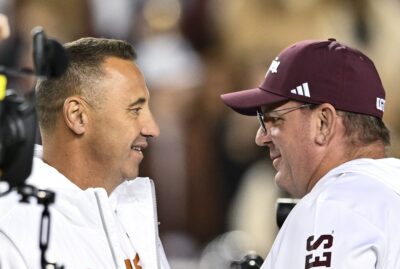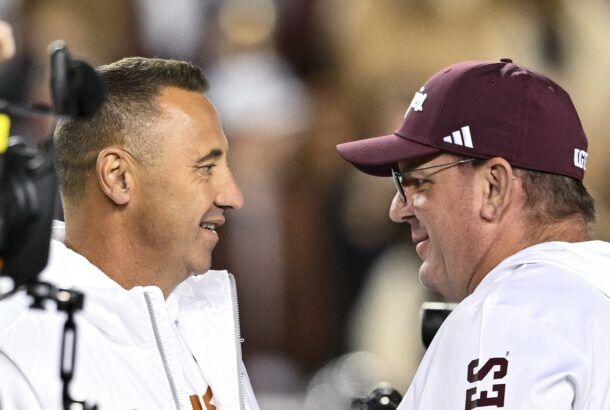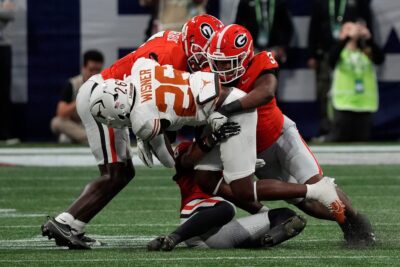Ad Disclosure

Mike Leach has a plan to fix college football. At least, the madness that is the marriage of name, image and likeness and the transfer portal.
Have patience, and work with him. You might just like The Leach Plan.
“I see that look you’re giving me,” Leach told me last week during SEC Media Days, in between his rotations of talking about his sneaky good Mississippi State team. “I’m telling you, this can work.”
There are no answers here, right? We all know the rules to NIL — and the only rules are there are no rules.
No guidelines, no best practices. No chance for any coach at any school to get a firm grip on paradigm change that’s whizzing by.
For a sport that had been so regimented for so long — and arguably, at the expense of players — the sudden switch to free-for-all has knocked college football sideways.
Enter, the aloof one. The thinker beneath the quirky shell.
Sit back and soak it in.
“What we have right now is unmitigated free agency and a bidding war,” Leach said.
So how do you stop it? Leach says split players into two specific groups: student-athletes and professionals. Players choose their group.
The student-athlete track, Leach estimates, is for “about 95 percent or more” of the current college players. They will sign and play under the current scholarship format — but with a back-loaded bonus structure.
“You come to school, get your full scholarship and stipend,” Leach said. “You can’t be cut for playing ability, but can be cut for breaking rules. You can’t be traded, you don’t get drafted.”
Wait, traded and drafted?
Hang tight, it gets better.
“If you finish all of your eligibility at the same school and graduate,” Leach says, and then suddenly stops. Because he wants to make something very clear.
“I don’t like taking the degree out of the equation,” he continues. “Degrees help lives, help families, help generations. Then at the end of your career and graduation — and I don’t know the perfect amount — let’s say you get $150,000.”
That’s a $150,000 retention bonus for signing a scholarship, playing 4 years of football and graduating in 5 years. All at the same school.
“Now, if you enter the transfer portal at any time, you’re no longer eligible for the $150,000,” Leach said. “If you don’t graduate, you don’t get the $150,000.”
That, Leach says, puts the onus of player and individual development on both coach and player. Players want the money at the end of the run, and have incentive to stay and develop athletically (for the NFL) and academically (for the $150,000).
Coaches are forced to get the most out of those players because they can’t force them out or cut them — and don’t want to deal with a player (or players) skating along to hit the $150,000 payday.
“Most players,” Leach says, “are probably better suited for the student-athlete (track).”
Then there’s the professional track, the group of players Leach says more closely align with the current explosion of NIL money and player movement.
You have a certain window of time during your senior year of high school to declare as a professional. Once that deadline passes, there will be a draft.
That’s right, a draft.
“Every other league does it that way,” Leach said. “Think about the crummiest sports league or the best, and they draft. Heck, Little League has a draft.”
To Leach’s point, that’s part of the gamble. If you enter as a professional — let’s say there are 200 players who enter as professionals at every talent level — you can be drafted by any team (or teams can pass).
“You declare you’re taking the professional track, and not long after, we have the draft,” Leach said. “There’s no bargaining and extorting (NIL) money from schools, playing one school against the other. Like hell you will. Not here. We’ll call you when you’re drafted and you’ll know what team you’re playing for.”
There’s no cap on NIL money. A professional track player can make as much as he can, with as many companies as he wants (basically, the current setup).
He can be cut at any time for any reason, just like the NFL. He can be traded.
He can move freely between schools annually, but there’s a window for movement. Something along the lines of 1 week after the season, and 1 week after spring practice.
“They want to be professionals, well, guess what? The NFL doesn’t have free movement,” Leach said. “You don’t get 365, 24/7 access to the portal, that’s madness. Your NFL friends will lose their minds if you tell them players get 365, 24/7 access to free agency.
“Everyone wants guardrails to this deal; well, here they are.”
Now, the problem with The Leach Plan: The current setup gives players the best of both of Leach’s worlds. Without negative side effects (see: guardrails).
In fact, the NCAA is closing in on making player movement even easier, proposing unlimited transfers without sitting out a season and losing a year of eligibility.
“We have unheard of privileges, more than NFL players enjoy,” Leach said. “It’s unsustainable the way it is. At some point, something has to happen.”
Maybe that something is The Leach Plan.
Matt Hayes is a national college football writer for Saturday Down South. You can hear him daily from 12-3 p.m. on 1010XL in Jacksonville. Follow on Twitter @MattHayesCFB




